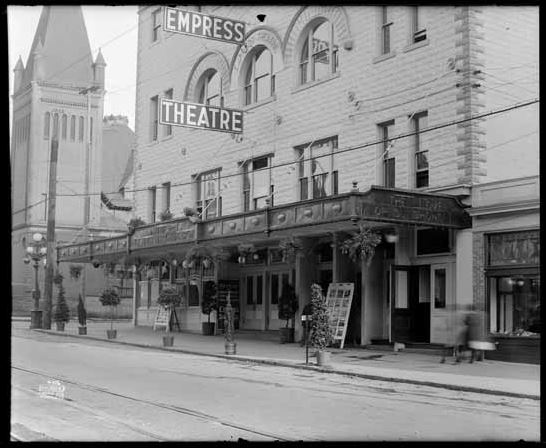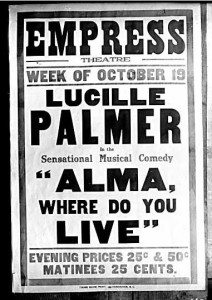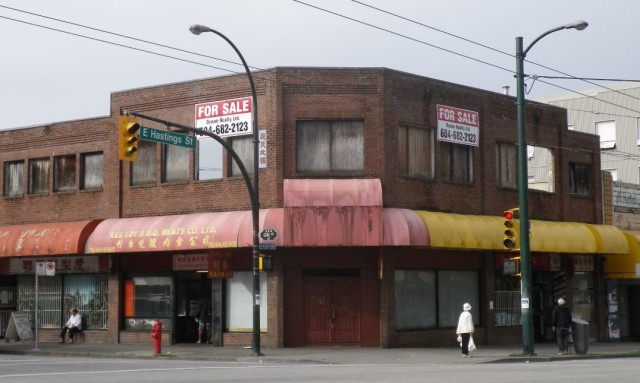
In 1913 Vancouver had a thriving theatre district that included eight movie theatres as well as stock theatres like the Pantages and the Empress——both completed in 1908.

Over the years we’ve managed to pretty well destroy all evidence of these theatres—the Capital, the Strand, two Orpheum theatres, and of course, most recently the Pantages Theatre at Main and Hastings that as Heritage Vancouver so succinctly put was “demolition by neglect.”
Theatre companies put on lavish productions at the Empress that called for sheep and horses on stage, as well as cars. For Faust, the stage crew built fire-breathing dragons 20-feet long; and for The Aviatrix they constructed a copy of the new Wright Brothers aeroplane and flew it on piano wire. At one point the Empress had the biggest stage west of Chicago.
By the late 1930s rising costs, movies and the shift of the city away from Main Street sounded the death knell for the Empress. But instead of finding a new use for the building, in 1940 down it came in a pile of rubble.
This is what we’ve done with the site.

For more posts see: Our Missing Heritage
© All rights reserved. Unless otherwise indicated, all blog content copyright Eve Lazarus.




12 comments on “Our Missing Heritage: The Theatre District”
I watch all this from far away in Norwich, England, but from my many visits to Vancouver I have come to care as much as anyone about this destruction that seems to go on and on. Here in East Anglia there are 12thC churches, 16thC pubs, old Georgian houses in droves… there are also monstrosities that have resulted from neglect and ignorance and a hurried desire to prioritize commercial interests, just like anywhere else. We can blame planners and councilors in the past for their ignorance… please let’s kept the current Vancouver lot awake and a lot more protective of that fast-vanishing heritage.
Thanks for the interesting post – the Empress really must have been something. It would have been great if even a couple of the original vaudeville/movie palaces could have been maintained – what civic treasures they would be now.
It was a sad loss when the first Pantages was demolished recently for condos, and I am blown away by the photos that I’ve seen of the second Panatages Theatre that was built on Hastings. It was later renamed the Beacon, then the Majestic. Both the exterior and interiors were magnificent, and it’s hard to believe something that beautiful once existed on Hastings. It was torn down in the late ’60’s to become a parking lot.
How big was the Empress? From the photo it looks to be four storeys at least.
Definitely 4 stories – here’s another picture taken in 1908 https://evelazarus.com/the-clydes-the-butlers-and-the-empress-theatre/
It sat 1,650 people.
David: The Daily News Advertiser of 14 June 1908, p. 16, gives a good description of the building on the eve (no pun intended) of its opening. RBT
“This is what we’ve done with the site.”
…..Whaaaaaaaaaaaaaat………!!!!!
Do you know the story of the False Creek Flats? A very interesting bit of Vancouver history. False Creek used to extend all the way to Clarke Drive. The east end of the creek, between Main Street and Clarke Drive, was filled in during the 1910s by two competing railroad companies and they built side-by-side terminus stations at the end of the west end of the reclaimed land. The one station still exists, but the other station was demolished in 1964. It was a beautiful building, complete with marble interior and chandeliers. Here is the link to a photo of the demolished station: http://searcharchives.vancouver.ca/union-station-great-northern-railway-depot
What a beautiful building and a great addition to my next what were we thinking blog. How sad!
There are many interesting photos at the Vancouver archives of the whole series of events surrounding the filling in of False Creek. There is documentation of building the two railways stations, photos of the two buildings side by side, etc. I even have a copy of the letter from the city clerk’s office regarding the abandonment of the station, March 8, 1962. According to an article about the demolition in the “Vancouver Times”, 90% of the building was recycled. If you’re interested in more info, I an give you more details. I did a research project in 2000 on the False Creek flats. I had read somewhere that False Creek used to extend much further inland, and was fascinated by the fact that it had been filled in. It is as much a history of the rise and fall of the great railway era in Canada, as it is the history of Vancouver.
The site will now become a mix of social and market housing, and some of the units will be priced at Welfare housing rates – yay!
Really! I’m so pleased to hear that we’re getting rid of that eyesore and doing some good with the space.
[…] Our Missing Heritage (part three) The Empress Theatre […]